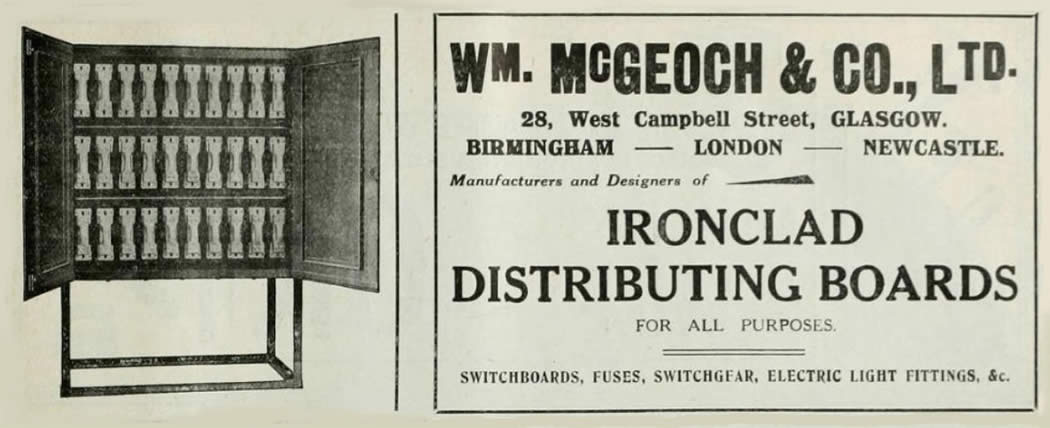Summary. During WWI, McGeoch focused on government contracts, notably producing standardised electric light fittings and other electrical equipment. Our Glasgow warehouse supported the Clyde shipbuilding industry, diversifying into hardware like coathooks. Post-war, McGeoch supplied fittings for significant ships, illustrating their crucial role in maritime manufacturing.
War-Time Innovations: Standardised Electrical Fittings and Maritime Hardware
During the First World War, McGeoch’s business primarily focussed on Government contracts for electrical and general equipment, especially for the Admiralty. The company manufactured a range of products, including standardised electric light fittings, watertight plugs, and sockets. They also produced switchboards, control panels, and switchgear. Furthermore, McGeoch made ironclad distributing boards, along with various other items of builders’ hardware and ships’ brassfoundry.
Careful management and expertise in manufacturing ensured maximum production at the Warwick Works in Birmingham. Meanwhile, the Glasgow warehouse, typically a distribution centre for the Clyde shipbuilding industry and Scotland, increased its workshop production. It focused on cargo connection boxes and a variety of other general and diverse hardware items. These included a range of coathooks, boathooks and, on one particular occasion, a shepherd’s crook for a Hebridean Crofter!
By 1919, with peace restoring the world’s principal merchant navies after huge losses, all leading shipping companies placed orders for new tonnage. These included Cunard, White Star, Canadian Pacific, Anchor, Donaldson, British India and Red Star.
Reviving the Atlantic Race: The Quest for the Blue Ribband
The race for the Blue Ribband of the Atlantic, held by ‘Mauretania’ since 1915, resumed with full intensity. Cunard’s preferred shipyard, John Brown, which was building ‘Acquitania’ when the war broke out, expanded its fleet. They added ‘Franconia’ in 1923 and ‘Alaunia’ in 1925. Oddly enough, William Beardmore, not John Brown, built Cunard’s first post-war ship, the ‘Lancastria’ (1922). This led to a successful decade for Beardmore and an interesting series of contracts for McGeoch. Between 1922 and 1925, McGeoch supplied many of the fittings that went into the magnificent public rooms and luxurious cabins of those ships.

Top: A magazine advertisement for McGeoch Ironclad Distributing Boards, circa 1922. Above: A magazine advertisement highlighting McGeoch’s ability to supply builders’ ironmongery as well as ships’ brassfoundry and electric fittings, circa 1921.
‘Lancastria’ was launched in 1920 as ‘Tyrrhenia’ by William Beardmore on the River Clyde for Anchor Line, a subsidiary of Cunard. She was the sister ship of ‘RMS Cameronia’ that Beardmore’s had built for the same customer the previous year. ‘Tyrrhenia’ was 16,243 gross register tons, 578 feet (176 m) long and could carry 2,200 passengers in three classes. She made her maiden voyage, Glasgow – Quebec City – Montreal, on 19th June 1922.
In 1924, workers refitted the ship for two classes and renamed her ‘Lancastria’ following passengers’ complaints about the difficulty in pronouncing ‘Tyrrhenia’. She sailed scheduled routes between Liverpool and New York until 1932, and then served as a cruise ship in the Mediterranean Sea and Northern Europe. With the outbreak of the Second World War, she transported cargo and was requisitioned in April 1940 as a troopship, becoming ‘HMT Lancastria’. During Operation Ariel, the evacuation of British nationals and troops from France two weeks after the Dunkirk evacuation, she sank on 17th June 1940 off the French port of St. Nazaire after several operations.

